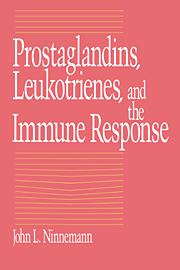Book contents
- Frontmatter
- Contents
- Foreword by James S. Goodwin
- Preface
- 1 A brief history and introduction
- 2 Prostaglandin/leukotriene structure and chemistry: a primer
- 3 Monocytes and macrophages
- 4 Lymphocyte response
- 5 Inflammation and the neutrophil
- 6 Malignancy and the arachidonic acid cascade
- 7 Tissue and organ transplantation
- 8 Rheumatoid arthritis and autoimmunity
- 9 Traumatic injury and surgery
- 10 Allergy
- Index
4 - Lymphocyte response
Published online by Cambridge University Press: 24 November 2009
- Frontmatter
- Contents
- Foreword by James S. Goodwin
- Preface
- 1 A brief history and introduction
- 2 Prostaglandin/leukotriene structure and chemistry: a primer
- 3 Monocytes and macrophages
- 4 Lymphocyte response
- 5 Inflammation and the neutrophil
- 6 Malignancy and the arachidonic acid cascade
- 7 Tissue and organ transplantation
- 8 Rheumatoid arthritis and autoimmunity
- 9 Traumatic injury and surgery
- 10 Allergy
- Index
Summary
It is now clear that the immunological activities of lymphocytes are profoundly affected by the presence of various products of arachidonic acid metabolism; however, many fundamental issues concerning this interaction remain unresolved and are, at times, hotly debated.
EICOSANOID PRODUCTION AND INTERACTION WITH LYMPHOCYTES
It has not been proven conclusively that normal lymphocytes possess either cyclooxygenase or lipoxygenase enzyme systems. This is stated with caution, since studies in vitro by Parker et al. (1) suggested that purified lymphocytes produced 5-HETE, 12-HETE, and TXB2, and Goetzl reported that T lymphocytes possess a 5-lipoxygenase system (2). Furthermore, Bauminger reported that mouse thymocytes could be differentiated on the basis of their PG synthetase activities (3). Mature thymocytes appeared to contain higher concentrations of PGE and greater PG synthetase activity than did immature cells. Webb and Nowowiejski reported that both nonadherent and glass-adherent T cells release PGE into the culture medium after phytohemagglutinin (PHA) stimularion (4).
Using thin layer chromatography (TLC) and/or radioimmunoassay (RIA) procedures, Aussel et al. recently demonstrated that Jurkat cells (a human leukemic T cell line) are able to convert arachidonic acid to 6-keto-PGF1α, PGE2, PGA2, and TXB2 (5). The addition of lectins or anti-CD3 monoclonal antibody reduced the amount of PG released by the cells, as did the addition of the cyclooxygenase inhibitors indomethacin and niflumic acid.
- Type
- Chapter
- Information
- Prostaglandins, Leukotrienes, and the Immune Response , pp. 53 - 96Publisher: Cambridge University PressPrint publication year: 1988
- 1
- Cited by



